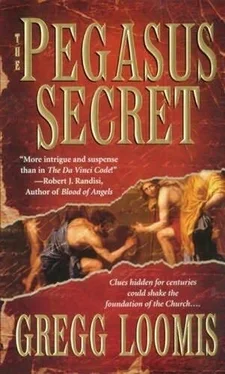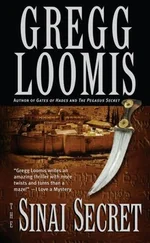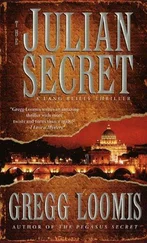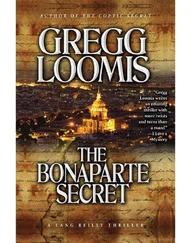I anticipated further infliction of pain. Instead,I was taken before the same inquisitor and instructed to divulge my initiation into the Order, a simple ceremony in which I was put before the Chapter during the presence of Jacques de Molay, the Grand Master. I was told that it would be a very hard matter to be the servant of another, meaning Our Lord and the Chapters superiors, having no will of my own. I was required to answer several questions: Whether I had a dispute with any man or owed any debts? Whether I was betrothed to any woman, at which point I and a number of Brothers, remembering I had been but a noviate in Sicily, smiled despite the seriousness of the intent of the question. Had I any infirmity of body? Whereupon the assembled chapter was asked if any had objection to my admission and upon unanimous answer that they did not, I was received into the Order.
My inquisitor frowned as scribes finished their transcripts, inquiring as to the nature of any oaths required of me. I spoke truly, that I swore upon the Book and upon the Cross that I would forever be chaste, obedient and live without property, whereupon the Grand Master kissed me upon the mouth, admonishing me to the following effect: I was henceforth to sleep in my shirt, drawers and stockings, girded with a small cord, to never tarry in a house where there was a woman large with child, to never attend a wedding nor 'the purification of a woman, to never raise a hand against another Christian except in self-defense, to be truthful.
Upon giving such testimony, I was returned to my cell.
Later Stephan told me that my words were the same as the other brothers examined that day, yet the inquisitor found it all to be perjury.
Had not Stephan so confided in me, I would have believed the multiple inquisitors set upon me who told me my brethren had all confessed. Indeed, these new askers of questions were more fearsome that the original ones who imposed torture, for several showed me kindness, weeping at my fate while cajoling me to purge my soul of corruption and confess, while their alternates slapped my face, threatened and prevented me from voiding either bladder or bowel except upon myself.
Pain is but transitory,,while damnation is eternal. I chose not to swear falsely against my brethren or the Order. I pray God may inspire my executioner to strangle me before my body is consumed by the flames. Of more significance, I pray my time in purgatory will be short before my Lord and all his saints receive me into heaven. I pray I may be forgiven the sin of pride which lured me· from my original station, which made me seek knowledge I should have not sought, which has caused me to question those things that are a matter of faith and to die in a state of torment of revelation I do not wish to heed.
I ask that you who find this writing pray for me also, for time on this earth and my supply of material with which to write quickly expire.
Conclusion by the Translator
There is no surviving complete list of the Templars who were burned at the stake in Paris between October of 1307 and April of 1310, if there ever was such a document. We know that de Molay made no effort to escape, believing to the last the name of the Order would be restored.
It is likely no such list ever existed, the very anonymity of the victims being part of the terror Philip wished to inspire in those hesitant to confess. To die without name was to die without sacrament or burial in consecrated ground, and, hence, without unction and subsequent hope of resurrection-a fearsome prospect in the early fourteenth century.
Whatever Pietro may have found in the cave that so shook his faith, we will never know, nor is it significant. What matters is his first hand account of life as a Templar, albeit a noncombatant, in the days after the retreat from Palestine.
His narrative will be of interest to historians for years to come.
N.W.
Rennes-le-Château
It was only a few minutes drive to Rennes-le-Château on a road as twisted as a bedspring and almost as narrow. A cluster of stone and plaster buildings clung to the top of a hill. Francis had been right about Saunière being something of a tourist industry. Two or three couples festooned with cameras wandered through narrow, mostly empty streets. A small visitors' center hawked postcards with Saunière's picture and books in multiple tongues on the possibilities of what he had found. Signs in three languages reminded guests it was illegal to dig on public property. Apparently the priest's find had inspired tales of buried treasure.
The small Romanesque church was no larger than the town's other buildings, its only remarkable feature the gilt border around its low door. The Church of Mary Magdalene, the guidebook said, built in 1867.
Saunière's church.
Lang went inside.
Just beside the door, he was surprised by the leering face of a carved stone devil, his twisted body painted red and squatting under the weight· of the holy water stoup. The vaulted ceiling was about twenty feet high and richly decorated with painted designs. The church itself was no more than a simple rectangle, with a center aisle dividing eight pews. The single room could not have held a hundred people. And yet every detail was as richly done as the largest cathedral.
The pulpit was carefully carved with the scene of an angel standing beside an empty cave.
The discovery that Christ had left the tomb.
Appropriate.
Everywhere Lang looked, he saw evidence of what had probably been the most skilled artists available. He understood Saunière's intent, to erect a place of quality and dignity that avoided ostentation. The priest had not intended to become an ecclesiastical parvenu.
Lang walked around, making a second inspection, impressed with the craftsmanship, the carving of the oak altar rail and pulpit steps. The altar, white marble, perhaps Carrara, was engraved with a triptych of Christ's birth, crucifixion and, again, an angel in an otherwise empty tomb. Curiously, this latter scene occupied the center rather than the chronologically correct last section.
Stations of the cross marched around the walls. Nothing unusual in a Catholic church, Lang thought. Until he came to fourteen, the last. Christ, half wrapped in a shroud, being carried to the tomb. But there was something… Above the figures, the moon. Lang was fairly certain Jewish law required a burial before sundown of the Friday before Sabbath. If so, perhaps the figures were not taking Him to the tomb. Another message from a dead priest? If Lang had had doubts as to what the priest had found, Saunière's church dispelled them.
Outside, he left the car parked to walk through the hamlet. A loaf of bread, cheese, sausage and bottled water made lunch, eaten while contemplating the church's facade.
Dusting off the crumbs, Lang cramped back into the little car. Once down the hill and on the other side of Rennes-les-Bains, the road began a steep ascent before it forked. Lang pulled onto a narrow shoulder and consulted the rental company's map. It was too small to have the detail he needed, so he peered in one direction, then the other, as though the answer might be coming down the road.
Actually, it was. Almost, anyway. Lang was turning his head to see when he spotted a stone cross to his left, mounted a few feet up the hillside. Such calvaire are common in the countryside of Catholic countries but this one wasn't alone. Beyond it was a statue of Christ, also not unusual. But Lang couldn't recall ever seeing both together. And this stature was a little different: instead of facing the passing motorist, it was perpendicular to the road, staring into the blue haze of the distance.
He got out of the car and climbed up to the cross. It bore no name but the conventional IN RI and a date too eroded by years of weather to be easily readable. The statue was life-size and mounted on a plinth as though to give Christ a better view of the hills and valleys. At one time, He had been pointing at something, judging from the extended right arm broken off at the elbow.
Читать дальше












